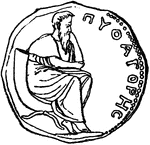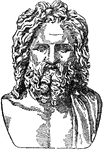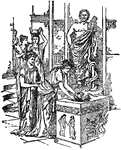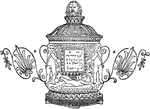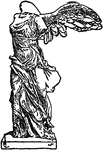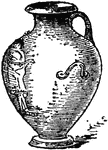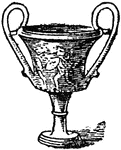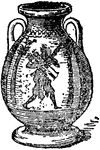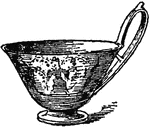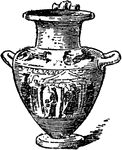
Lycian Tomb
"Lycia was, in ancient geography, a country on the S. coast of Asia Minor, extending toward Mount Taurus,…
Tragedy masks
"Tragedy masks. The origin of Greek drama is to be found in the yearly celebrations in honor of Dionysus,…
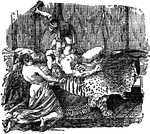
Man with ax
"Who brandishing aloft the ax of doom, That just has laid one victim at her feet, Looks round her for…
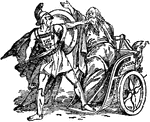
Death of Laius
"When grown up, Oedipus is told by the oracle that he would slay his father and marry his mother. On…

Thesus and the Minotaur
"Thesus and the Minotaur. (From a vase-painting in the Vatican Museum.) — The Delphian Society,…
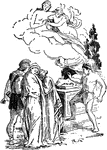
Rescue of Iphigenia
"When she was about to be slain at the altar, Artemis intervened and carried her off in a cloud to be…
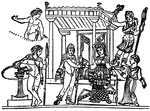
Iphegnia delivers letter to Pylades
"What in this letter is contained, what here, Is written, all I will repeat to thee, That thou mayst…
Comedy masks
"While Greek tragedt grew farther and farther away from the humor and burlesque so characteristic of…

Greek philosophers
"Greek Philosophy, which reached its highest excellence in Athens in the fourth century before Christ,…
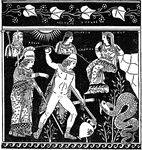
Cadmus and the Dragon
"Cadmus and the Dragon. (From a vase-painting at Naples.)" — The Delphian Society, 1913

Pericles
"So long as Pericles stood at the head of Athens in time of peace, he governed it with moderation and…

Ancient Athens
"The mosted noted of the orations of Isocrates is the Panathenaicus or Panegyric of Athens, a work on…
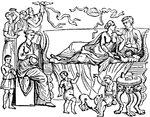
Accubatio
"The act of reclining at meals. The Greeks and Romans were accustomed, in later times, to recline at…

Aeschines
"Aeschines owes the perpetuity of his fame to the fact he was the only rival of Demosthenes. He was…

Demosthenes
"In the oratory of more thn two thousand years Demosthenes stands in the front rank, and will always…

Aegis
"signifies, literally, a goat skin. According to ancient mythology, the aegis worn by Jupiter was the…

Alcaeus
"Besides Sappho, her friend, perhaps lover, Alcaeus is almost the sole representative of the Aeolic…

Anacreon
"Though Anacreon has been famous as the poet of wine and love, few geniune fragments of his songs have…

Theocritus
"The fame of Theocritus, the prince of bucolic poetry, depends on his faithful pictures of natural scenery…

Polyphemus
"Theocritus asserts that there is no rememdy for Love but the Muses. He then gives an account of the…
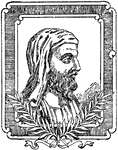
Plutarch
"Plutarch, as the great interpreter of Greece and Rome, exerted on generations succeeding him in influence…

Lucian
"Lucian, the humorous satirist, was a native of Samosata, in Syria, and flourished towards the end of…

Julian
"Thus the prince, both when present and when coming, was alike victorius: and these things he achieved…
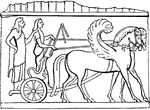
Antyx
"The rim or border of anything, especially of a shield or chariot. The trim of the large round shield…

Aplustre
"An ornament of wooden planks, which constituted the highest part of the poop of a ship. From the representations…
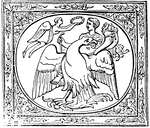
Apotheosis
"The enrollment of a mortal among the gods. The mythology of Greece contains numerous instances of the…

Arcus
"The bow used for shooting arrows, is one of the most ancient of all weapons, but is characteristic…
Arcus
"The bow used for shooting arrows, is one of the most ancient of all weapons, but is characteristic…
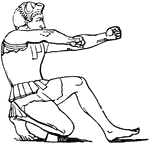
Arcus
"The bow used for shooting arrows, is one of the most ancient of all weapons, but is characteristic…
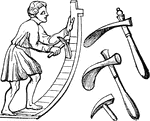
Ascia
"An adze. Muratori has published numerous representations of the adze, as it is exhibited on ancient…

Aurum
"Gold appears not to have been coined at Athens till the time of the Macedonian empire, with the exception…

Cantharus
"A king of drinking cup, furnished with handles. It was the cup scred to Bacchus, who is frequently…

Sandal
"The Sandal is a protection for the foot, worn in ancient times. It was usually a sole of hide, leather,…
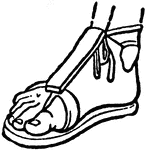
Sandal
"The Sandal is a protection for the foot, worn in ancient times. It was usually a sole of hide, leather,…

Sandal
"The Sandal is a protection for the foot, worn in ancient times. It was usually a sole of hide, leather,…

